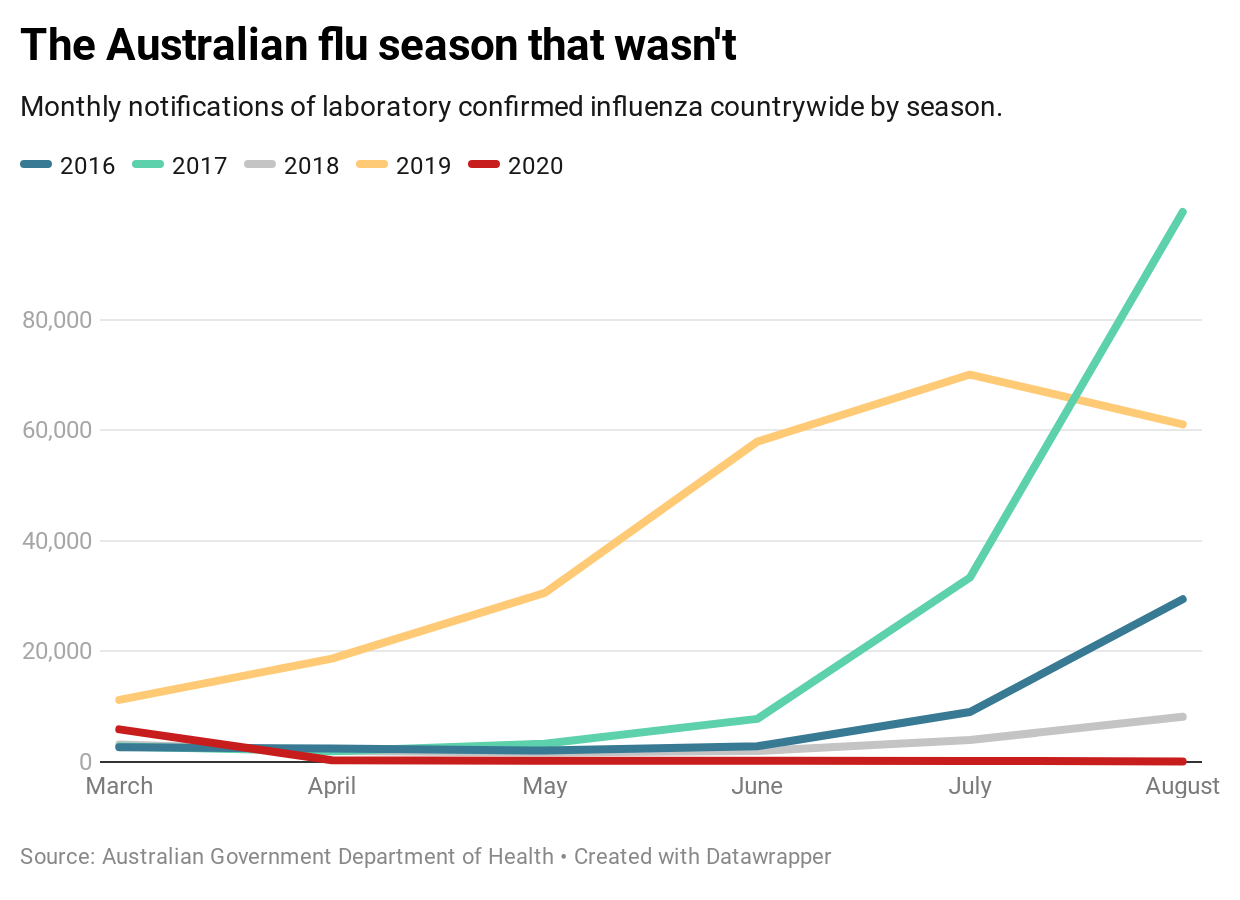This is how flu season might affect the COVID-19 curve

COVID-19 and flu: devastating combination or negligible threat? Image: REUTERS/Brian Snyder - RC24MF9UB0A3
- The Southern Hemisphere largely avoided a combined flu season and pandemic.
- A heavy flu season in the midst of COVID-19 could overwhelm health systems.
- Experts have mixed views on whether the Northern Hemisphere will fare as well when the weather turns.
Several months ago, the inhabitants of one half of the planet braced for a potentially devastating addendum to COVID-19 as another flu season approached. And then, nothing.
In much of the Southern Hemisphere, a meaningful flu season mostly failed to materialize as usual in April – around the time autumn is poised to become winter. Now, in what is often the peak period for reported cases, they continue to lag well behind the norm.
For many experts, the notion of dealing with a heavy flu season and a pandemic at the same time is daunting. The combination could overwhelm health systems, and complicate the ability to make accurate diagnoses. Yet, the lack of flu season in the Southern Hemisphere was not entirely welcome.
That’s because the rest of the world north of the equator, including places that have struggled to contain COVID-19 during summer, now lacks a detailed blueprint for dealing with a combined flu season and pandemic as the weather begins to turn.
Researchers hoping to study the interaction between seasonal flu and the coronavirus came up empty in the Southern Hemisphere in recent months. In South Africa, government laboratories that would normally record more than 1,000 cases of flu between April and August instead recorded a single case. Meanwhile Australia reported 193 notifications of laboratory-confirmed influenza for July – compared with 70,071 in the same month last year.

Reasons for the diminished influenza spread in the Southern Hemisphere include social distancing and other measures implemented to combat COVID-19. Influenza and the coronavirus spread in similar ways, including via droplets emitted through coughing and talking. They also both put the elderly and people with chronic medical conditions at greater risk.
Now, countries in the Northern Hemisphere, including the US where flu season normally begins around October, must rely on flu shots and whatever preventive measures that have been put in place to fight COVID-19 – and are being adhered to – in order to likewise keep influenza in check.
The WHO has so far estimated that the crude mortality ratio for COVID-19 is between 3% and 4%, while mortality is usually well below 0.1% for seasonal influenza. Still, “influenza-pneumonia” is among the leading causes of death in the US. During the 2018-2019 flu season, it resulted in nearly 500,000 hospitalizations there and an estimated 34,157 fatalities.

Experts seem to have mixed views on whether the Northern Hemisphere will now be better off thanks to the lack of influenza spread in the other half of the globe. In any case, they suggest getting a flu shot – to better protect against a perfect storm of influenza and coronavirus as we await a COVID-19 vaccination.
For more context, here are links to further reading from the World Economic Forum’s Strategic Intelligence platform:
- Seasonal flu contributes substantially to hospitalization and mortality, especially among infants and the elderly. This recent study suggests that locating influenza vaccination programs in schools can decrease both hospitalizations of the elderly and school absences. (Science Daily)
- The Northern Hemisphere has already blunted one flu season with coronavirus-related measures – seasonal flu cases in the Northern Hemisphere usually tail off at the end of May, but this year laboratory-confirmed cases dropped precipitously in early April, according to this report. (Nature)
- If more than the 45% of Americans who received vaccinations during the last flu season get immunized this time around, it could help head off a nightmare scenario in that country come wintertime, according to this report. (Kaiser Health News)
- Just as indigenous people have suffered inordinately from COVID-19, many bore the brunt of the influenza of 1918. This journal article uncovered an undercounting of the influenza death rate on the Navajo Nation in the US, where it may have killed as much as 18% of the population. (JSTOR Daily)
- When the governor of Florida said publicly that COVID-19 poses a lower risk to schoolkids than seasonal influenza, this publication took a closer look at the evidence behind his assertion. Turns out, he was partly right – albeit with many caveats. (Kaiser Health News)
- Vaccine science is tricky. There is no such thing as “a” flu, and the many strains of influenza and constant mutation mean that vaccines only last for about a year. And they always require guesswork. (Big Think)
- The coming weeks represent a crucial moment for an ambitious plan to try to secure COVID-19 vaccines for hundreds of less-affluent countries, after wealthy countries opted to buy their own. (STAT)
On the Strategic Intelligence platform, you can find feeds of expert analysis related to Vaccination, COVID-19 and hundreds of additional topics. You’ll need to register to view.
Don't miss any update on this topic
Create a free account and access your personalized content collection with our latest publications and analyses.
License and Republishing
World Economic Forum articles may be republished in accordance with the Creative Commons Attribution-NonCommercial-NoDerivatives 4.0 International Public License, and in accordance with our Terms of Use.
The views expressed in this article are those of the author alone and not the World Economic Forum.
The Agenda Weekly
A weekly update of the most important issues driving the global agenda
You can unsubscribe at any time using the link in our emails. For more details, review our privacy policy.

